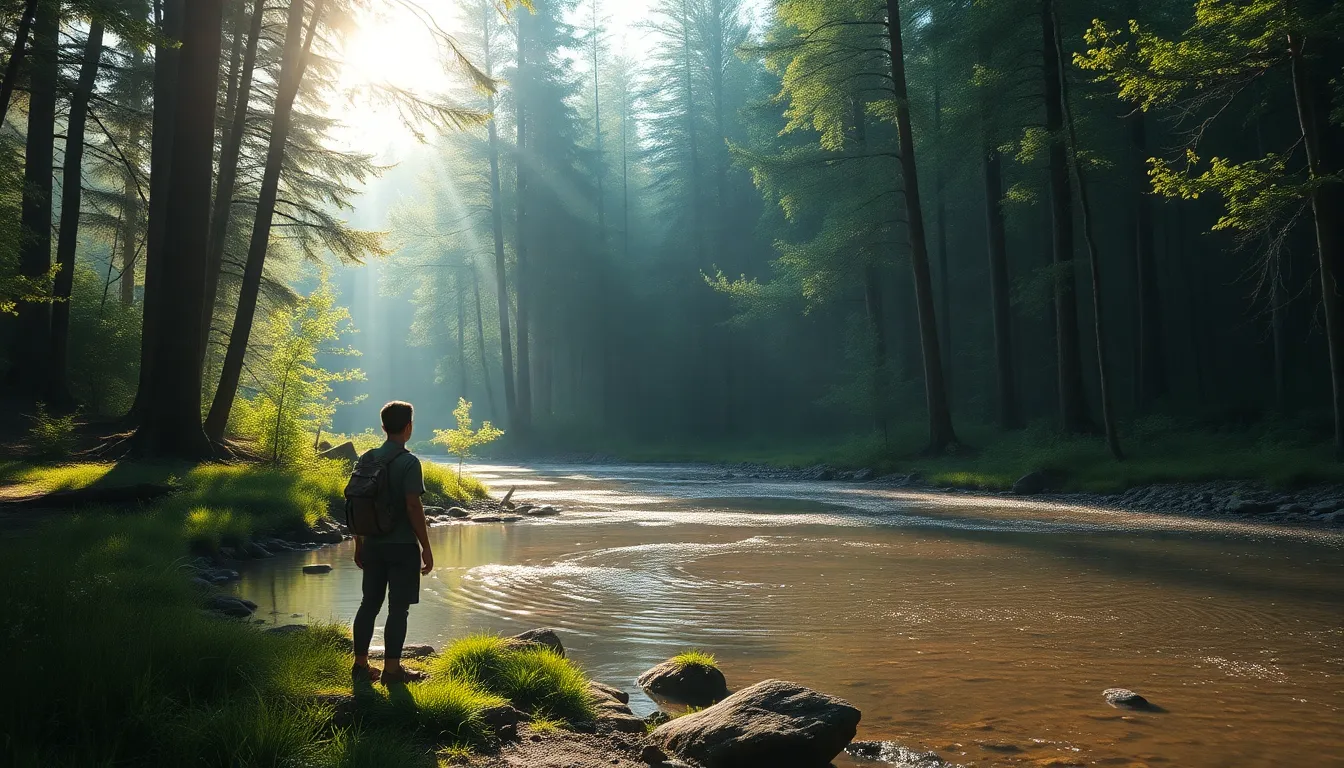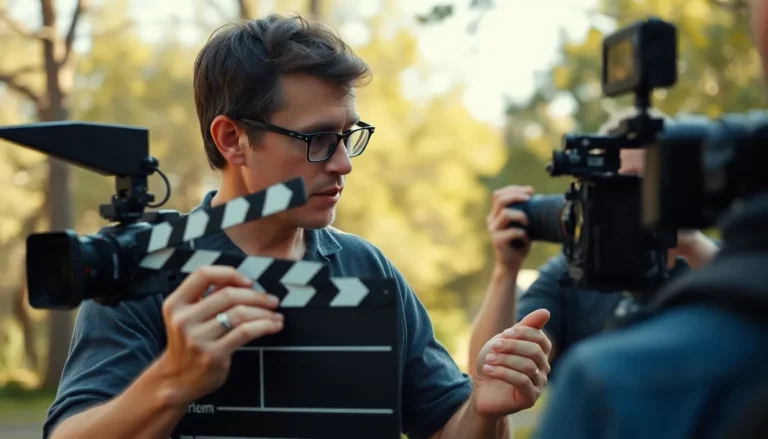Movies have a knack for weaving intricate motifs that can leave audiences pondering long after the credits roll. From the classic “damsel in distress” to the ever-popular “hero’s journey,” these recurring themes not only add depth but also create a rich tapestry that makes films unforgettable. Ever wondered why you can’t shake that feeling of déjà vu after watching a flick? Spoiler alert: it’s probably a motif at play.
Exploring these motifs is like embarking on a cinematic treasure hunt. Each film is a clue, leading to a greater understanding of storytelling’s universal truths. So grab your popcorn and put on your detective hat. It’s time to dive into the world of movie motifs and discover the hidden gems that make cinema so captivating. Who knows? You might just impress your friends with your newfound knowledge—or at least have a good laugh trying.
Table of Contents
ToggleUnderstanding Movie Motifs
Movie motifs serve as significant elements in storytelling. These patterns or themes enhance the narrative and create connections within films.
Definition of Movie Motifs
Movie motifs represent recurring symbols or concepts that appear throughout a film. These elements can manifest as visual images, themes, or phrases. For example, a red rose might symbolize love, while a recurring rain scene might evoke sadness. Directors use motifs as a cohesive force, weaving them into the fabric of a story to create depth and resonance. Recognizing these motifs enables audiences to understand the film’s deeper messages.
Importance in Filmmaking
Motifs play a crucial role in filmmaking. They contribute to world-building and characterize key relationships or conflicts. A filmmaker intentionally employs motifs to guide viewer emotions or highlight themes. For instance, the motif of light versus darkness often signifies the battle between good and evil. These recurring elements also enhance discussions about the film, inviting audiences to analyze and interpret complex meanings. Understanding motifs enriches the overall cinematic experience, making films more engaging and memorable.
Popular Movie Motifs

Recurring motifs play a significant role in film narratives, providing depth and resonance. Several motifs frequently appear in movies, including themes related to nature, love, and heroism.
Nature and Environment
Nature often serves as a backdrop for character development and thematic exploration. Films like The Revenant showcase the relationship between humans and their surroundings, highlighting survival amidst harsh landscapes. Storms can symbolize internal turmoil, while serene settings may evoke peace. Environmental issues also emerge in stories about climate change, emphasizing humanity’s responsibility to protect the planet. Such motifs underscore the interconnectedness of life, encouraging audiences to reflect on their own relationship with nature.
Love and Relationships
Love motifs are essential in establishing emotional connections between characters. Romantic films like The Notebook depict love’s transformative power, illustrating growth through relationships. Family bonds also feature prominently, showcasing the importance of connection and support. Friendship motifs appear in stories like Stand By Me, emphasizing loyalty and shared experiences. Each portrayal reveals different aspects of love, allowing audiences to relate to the characters’ journeys and foster empathy.
The Hero’s Journey
The hero’s journey represents a timeless narrative arc that resonates across cultures. Films such as Star Wars exemplify this motif, where the protagonist embarks on a quest marked by challenges and growth. Heroes often traverse unfamiliar worlds, facing adversaries that test their resolve. Mentors frequently guide them, imparting wisdom that shapes their transformation. Each journey not only entertains but also inspires, emphasizing resilience and the potential for personal growth through adversity.
How to Discover Movie Motifs
Exploring motifs enhances the viewing experience. Analyzing key elements in films reveals deeper meanings.
Analyzing Film Structure
Film structure establishes narrative flow and pacing. Begin by identifying the three-act format, which includes setup, confrontation, and resolution. Each act often emphasizes specific motifs that reinforce the story. Notice character arcs within the structure, as protagonists often evolve alongside recurring symbols. Identify plot devices such as foreshadowing and callbacks, since they highlight critical themes. Consider the climax, where motifs usually converge and leave a significant impact. Recognizing these elements promotes a deeper appreciation of film craftsmanship.
Noticing Visual and Audio Cues
Visual and audio cues play vital roles in conveying motifs. Pay attention to color palettes; they often symbolize emotions or themes. For instance, red may signify passion or danger, while blue evokes calmness. Listen for recurring musical themes as they frequently accompany specific characters or ideas. Dialogue also contains motifs; phrases may reveal underlying tensions or character relationships. Utilize these auditory and visual signals to enhance understanding of the film’s narrative. Observing these cues creates a richer cinematic experience and fosters a deeper connection with the material.
Examples of Movies with Strong Motifs
Recurring motifs enrich films and resonate with audiences, enhancing the storytelling experience. The following examples include classic and contemporary films that showcase the power of these motifs.
Classic Films
Classic films often contain motifs that define their narratives. Casablanca utilizes the motif of sacrifice, evident in Rick’s choices for love and friendship during wartime. The Wizard of Oz features the motif of home, emphasized by Dorothy’s desire to return to Kansas, making her journey relatable. Another classic, Gone with the Wind, showcases the motif of survival as Scarlett O’Hara navigates personal and societal upheaval. These examples illustrate how motifs shape character development and emotional depth, allowing viewers to connect with timeless themes.
Contemporary Films
Modern films continue to explore strong motifs that define their stories. Inception employs the motif of dreams versus reality, challenging viewers to question their perceptions throughout the film. Another example is Get Out, where the motif of racial tension underscores societal issues, making the horror all the more impactful. La La Land integrates the motif of ambition, highlighting the struggles of love and career in the pursuit of dreams. Each of these contemporary films uses motifs to create profound connections, furthering audience engagement and reflection on relevant themes.
Exploring movie motifs opens up a world of deeper understanding and appreciation for cinema. By recognizing these recurring symbols and themes, audiences can engage with films on a more meaningful level. This journey not only enhances the viewing experience but also sparks conversations that can lead to new insights.
As viewers become more attuned to the motifs that shape narratives, they cultivate a richer connection with the characters and stories presented on screen. Whether it’s the timeless hero’s journey or the powerful symbolism of love, these motifs serve as bridges between the film’s world and the audience’s own experiences. Embracing this exploration can transform the way one watches movies, making each film a unique adventure filled with layers of meaning.




